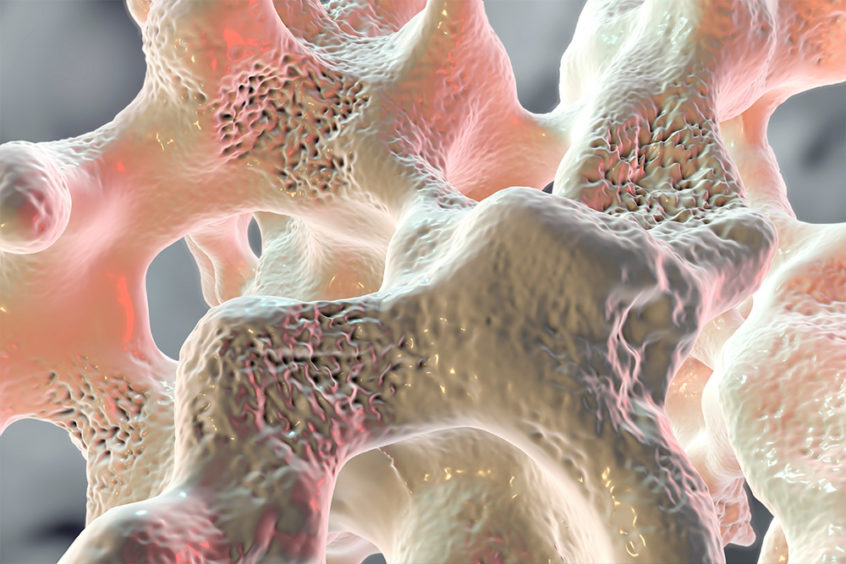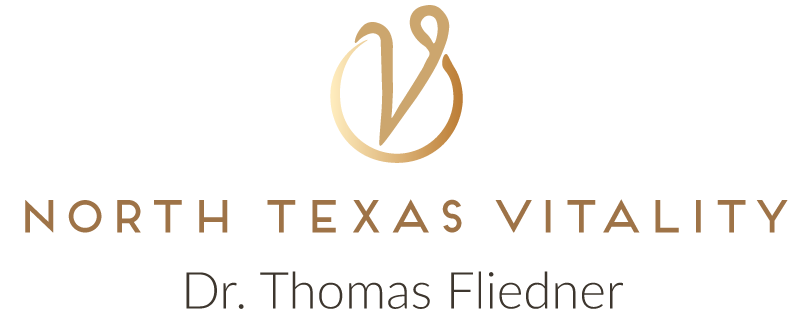Treating Osteoporosis with BHRT

Today, osteoporosis is a major public health problem in the United States. According to the National Osteoporosis Foundation, 54 million Americans, half of all adults age 50 and older, are at risk of breaking a bone and should be concerned about bone health.
As a board-certified ob-gyn, Dr. Fliedner takes his responsibility seriously to protect patients against osteoporosis by providing them with information on preventing the onset of this disease. With that in mind, we offer the latest findings on osteoporosis and how to treat osteoporosis with (BHRT).
What is Osteoporosis?
Osteoporosis is a bone disease characterized by low bone mass and loss of bone structure, leading to fragile bones and an increased risk of fracture. Our bones are living tissue that is constantly being broken down and replaced. Osteoporosis occurs when the creation of new bone doesn’t keep up with the loss of old bone.
While the cause of osteoporosis is not well understood, it is known that hormones are involved in regulating bone formation. As we age, the absence of estrogen or testosterone causes bones to become weaker and more prone to fracture.
It’s important to note that the risk of developing osteoporosis increases with age. The average age of diagnosis is sixty-five years old. But there are many other factors that can increase a person’s risk of developing osteoporosis including family history, race, gender, smoking, alcohol consumption, and diet.
Who Is at Risk of Osteoporosis?
Osteoporosis affects women and men of all races and ethnic groups; however, the disease is more prevalent in women than men. It is also more common in people who are older, have a family history of the disease, or are of Caucasian descent.
Among population groups, here’s what we know:
- Osteoporosis is most common in non-Hispanic white women and Asian women.
- African American and Hispanic women have a lower risk of developing osteoporosis, but they are still at significant risk.
- Among men, osteoporosis is more common in non-Hispanic whites.
Osteoporosis is not just an old person’s disease. It affects people of all ages, including children and young adults. Some children and teens develop a rare form of idiopathic juvenile osteoporosis; however, most children recover without treatment.
You might be surprised to learn that many common medical conditions can increase your personal risk of osteoporosis. Medical conditions that can lead to osteoporosis are the following:
- Anorexia. If you have a current or past history of anorexia, then your risk for low bone density is higher. This is because anorexia is associated with the absence of ovulation and low estrogen levels, and estrogen is critical to bone health.
- Celiac Disease. If you have celiac disease, which is a disease of the small intestine, then your absorption of calcium is affected and this can lead to osteopenia and osteoporosis. Given the underlying malabsorption associated with celiac disease, even if you take enough dietary or supplemental calcium, you still may not be able to absorb the calcium in order for it to be beneficial to your bones.
- Low Testosterone. If you are a man and have low testosterone, you are also at risk for reduced bone density. Not every man with “low T” has symptoms, so if you are obese, have diabetes, take opioid medications regularly, or have sleep apnea, you should talk to your doctor about your risk for “low T” and osteoporosis.
Symptoms of Osteoporosis
The symptoms of osteoporosis are hard to detect. It is called the “silent” disease” because a patient is unaware of any symptoms until a bone breaks or one or more vertebrae collapses (fracture). Symptoms of vertebral fracture can include severe back pain, loss of height, or spine malformations such as a stooped or hunched posture, also known as kyphosis.
Unfortunately, osteoporosis creeps up on its victims over time. It causes the bones to become so fragile that a fracture can occur spontaneously from simple, daily activities such as bending, lifting, or even coughing. The areas of the body most at risk of fracture are the wrists, hips, and the lumbar spine, and a fracture can lead to significant pain and loss of function.
Estrogen’s Effect on Bone Health
Although we do not understand exactly how estrogen affects bone health, scientists are learning more each day about the complex relationship between estrogen levels and bone health.
Our bones are in a constant state of change, breaking down old bone and making new bone. Healthy levels of estrogen can directly affect bone health at the cellular level by promoting the activity of the bone cells–osteocytes, osteoclasts, and osteoblasts. When estrogen levels drop, the bone cells are not able to effectively produce new bone tissue, leading to porous, weakened bones, and osteoporosis.
Estrogen replacement therapy used to be the only FDA-approved treatment to prevent osteoporosis. Now other drugs and medications are available to treat osteoporosis, but estrogen still remains the most prescribed treatment to conserve bone mass and prevent osteoporosis-related fractures in post-menopausal women.
By taking estrogen, a woman can help slow bone loss and can even regain bone density because estrogen works with the body’s bone-building cells to stimulate bone formation and slow the process of bone loss.
How to Treat Osteoporosis
The National Library of Medicine confirms that estrogen can increase bone density, preserve BMD, and successfully protect the bone structure in postmenopausal women.
When treating a woman for osteoporosis, Dr. Fliedner treats the whole person and will prescribe a Bioidentical Hormone Replacement Therapy (BHRT) that will effectively reverse the effects of bone loss. Before he prescribes the estrogen therapy, Dr. Fliedner tests your hormone levels. In addition, he will want to learn your medical history in order to prescribe a custom hormone therapy designed to replenish the hormones that your body needs.
With over 30 years of practice as an ob-gyn, Dr. Fliedner is an expert in Bioidentical Hormone Replacement Therapy. If you are concerned about your bone health, we invite you to make an appointment with Dr. Fliedner on our contact form or by calling our office at 469-455-1665.
More Information
For More Information on BHRT and osteoporosis, below are links to other articles on our website and to outside resources.
